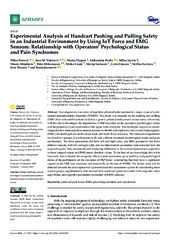Приказ основних података о документу
Experimental Analysis of Handcart Pushing and Pulling Safety in an Industrial Environment by Using IoT Force and EMG Sensors: Relationship with Operators’ Psychological Status and Pain Syndromes
| dc.creator | Petrović, Miloš | |
| dc.creator | Vukićević, Arso M. | |
| dc.creator | Đapan, Marko | |
| dc.creator | Peulić, Aleksandar | |
| dc.creator | Jovičić, Miloš | |
| dc.creator | Mijailović, Nikola | |
| dc.creator | Milovanović, Petar | |
| dc.creator | Grajić, Mirko | |
| dc.creator | Savković, Marija | |
| dc.creator | Caiazzo, Carlo | |
| dc.creator | Isailović, Velibor | |
| dc.creator | Mačužić, Ivan | |
| dc.creator | Jovanović, Kosta | |
| dc.date.accessioned | 2023-03-23T13:24:50Z | |
| dc.date.available | 2023-03-23T13:24:50Z | |
| dc.date.issued | 2022 | |
| dc.identifier.issn | 1424-8220 | |
| dc.identifier.uri | http://gery.gef.bg.ac.rs/handle/123456789/1217 | |
| dc.description.abstract | Non-ergonomic execution of repetitive physical tasks represents a major cause of work-related musculoskeletal disorders (WMSD). This study was focused on the pushing and pulling (P&P) of an industrial handcart (which is a generic physical task present across many industries), with the aim to investigate the dependence of P&P execution on the operators’ psychological status and the presence of pain syndromes of the upper limbs and spine. The developed acquisition system integrated two three-axis force sensors (placed on the left and right arm) and six electromyography (EMG) electrodes (placed on the chest, back, and hand flexor muscles). The conducted experiment involved two groups of participants (with and without increased psychological scores and pain syndromes). Ten force parameters (for both left and right side), one EMG parameter (for three different muscles, both left and right side), and two time-domain parameters were extracted from the acquired signals. Data analysis showed intergroup differences in the examined parameters, especially in force integral values and EMG mean absolute values. To the best of our knowledge, this is the first study that evaluated the composite effects of pain syndromes, spine mobility, and psychological status of the participants on the execution of P&P tasks—concluding that they have a significant impact on the P&P task execution and potentially on the risk of WMSD. The future work will be directed towards the development of a personalized risk assessment system by considering more muscle groups, supplementary data derived from operators’ poses (extracted with computer vision algorithms), and cognitive parameters (extracted with EEG sensors). | sr |
| dc.language.iso | en | sr |
| dc.publisher | MDIP, Basel | |
| dc.relation | info:eu-repo/grantAgreement/ScienceFundRS/AI/6524219/RS// | sr |
| dc.rights | openAccess | sr |
| dc.rights.uri | https://creativecommons.org/licenses/by/4.0/ | |
| dc.source | Sensors | sr |
| dc.subject | push and pull | sr |
| dc.subject | forces | sr |
| dc.subject | EMG | sr |
| dc.subject | psychological status | sr |
| dc.subject | pain syndromes | sr |
| dc.title | Experimental Analysis of Handcart Pushing and Pulling Safety in an Industrial Environment by Using IoT Force and EMG Sensors: Relationship with Operators’ Psychological Status and Pain Syndromes | sr |
| dc.type | article | sr |
| dc.rights.license | BY | sr |
| dc.citation.volume | 22 | |
| dc.citation.issue | 19 | |
| dc.citation.spage | 7467 | |
| dc.citation.rank | M21 | |
| dc.identifier.doi | 10.3390/s22197467 | |
| dc.identifier.scopus | 2-s2.0-85139811297 | |
| dc.identifier.fulltext | http://gery.gef.bg.ac.rs/bitstream/id/3032/sensors-22-07467.pdf | |
| dc.type.version | publishedVersion | sr |


